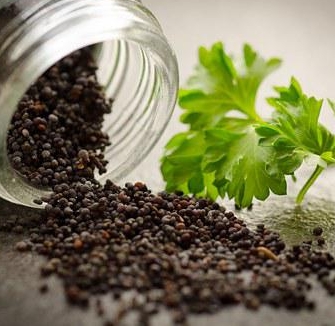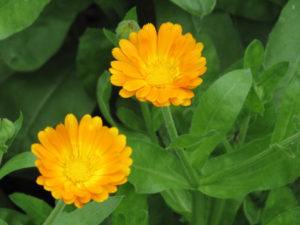THE SUNSHINE HERB!
We all could use a little more sunshine in our lives especially when it’s cheery, bright and in the shape of a beautiful flower called calendula. Not only is calendula beautiful, but it is an amazing herb to use on the skin.
It clears completions, improves acne, stimulates circulation and soothes the skin, just to name a few of its properties.
Known as the herb of the sun by English herbalists because the flowers close at sunset and open again at sunrise. (1) A twelfth century herbal states that calendula clears the head, improves eyesight and encourages cheerfulness by simply looking at it. (1)
Calendula has been used for centuries as a culinary, medicinal and magical herb.
It was believed that calendula could bring protection against dangerous influences. The seventeenth century astrologer and doctor, Nicholas Culpeper, taught that the marigolds were under the influence of the constellation Leo. The flowers, he said were “a comforter of the heart and spirits.” (5)
Calendulas colorful petals have been used in place of Saffron to color butter, rice, desserts and egg dishes. They have also been used in liquors as a dyeing agent. (3)
What a beautiful plant and what a joy to work with!
I have to say I have loved calendula for quite some time and have been using it in my facial hygiene products for at least a few months. Getting to work with it really just showed me more of its many amazing properties.
I did two tests on calendula. The first was a basic tea steep. I boiled about 15oz of water and poured it over dried calendula flowers, covered it and let it steep for about 20 minutes.
MY OBSERVATIONS:
Tea steep: I noticed myself feeling content and happy. I felt calm and my thoughts were collective, as though I could see things a bit more clearly. I noticed my stomach warming up slightly and noticed later it seemed to settle and soothe my stomach and digestive tract.
Facial toner:
The second test was a sort of toner that consisted of rose petals, calendula, chickweed, organic alcohol and water. I mixed all the ingredients together and put it in the fridge to maintain freshness.
Every day twice a day I apply the toner to my face. It drastically improves my completion, calms inflammation and helps to diminish blemishes. I notice my skin tone to be more even and I notice the redness to diminished or evened out.

http://www.schoolhousesoaps.com/images/Calendula_web.jpg
CALENDULA MATERIA MEDICA
Latin name: Calendula officinalis
Family: Asteraceae family
Parts used: flowers
Actions: diaphoretic, calmative, antispasmodic, sedative, carminative, emmenagogue and stomachic. (5)
Preparation and dosage:
- Tea: 4-8oz 2-3 times daily
- Tincture: 20-40 drops 2-3 times daily
- Essential oil: topically with a carrier oil as needed (3)
Uses:
Calendula is an herb for the skin! It clears complexions, soothes burns, calms inflammation, diminishes fungal infections, stimulates circulation and helps with varicose veins. It treats acne, improves herpes sores, soothes eczema and psoriasis and is a complete full body moisturizer. (1, 2)
It has a mild effect on increasing white blood cell counts, which aids in fighting infection and is similar to arnica in its ability to speed up tissue growth and healing time. (3)
Internally Calendula is a great menses regulator, it clears congestion, and dries dampness. There have been studies confirming calendula to inhibit the growth of E. coli, staph and some protozoa’s.
Cautions:
Calendula should not be used during pregnancy. (5)
References:
1. Edwards, Gail Faith. Opening Our Wild Hearts to the Healing Herbs. Woodstock, NY: Ash Tree Pub., 2000. Print.
2. Kaminski, Patricia, and Richard Katz. Flower Essence Repertory: A Comprehensive Guide to North American and English Flower Essences for Emotional and Spiritual Well-being. Nevada City, CA: Flower Essence Society, 1994. Print.
3. Mars, Brigitte. The Desktop Guide to Herbal Medicine: The Ultimate Multidisciplinary Reference to the Amazing Realm of Healing Plants, in a Quick-study, One-stop Guide. Laguna Beach, CA: Basic Health Pub., 2007. Print.
4. Moore, Michael. Medicinal Plants of the Mountain West. Santa Fe: Museum of New Mexico, 2003. Print.
5. PDR for Herbal Medicine. Montvale, NJ: Thompson Healthcare, n.d. Print.
6.Tierra, Michael, and David Frawley. Planetary Herbology: An Integration of Western Herbs into the Traditional Chinese and Ayurvedic Systems. Twin Lakes, WI: Lotus, 1988. Print.
Browse by category
- Aromatherapy
- Astrology & Magic
- Ayurdeva
- Botany Foraging & Gardening
- Chakras
- Digestion
- Earth Connection
- Energetics
- Flower & Gem Essences
- Folk Traditions
- Herbalism & Holistic Health
- Immune Support
- Materia Medica
- Mushrooms
- Nutrition
- Seasonal Living: Autumn
- Seasonal Living: Moon
- Seasonal Living: Spring
- Seasonal Living: Summer
- Seasonal Living: Winter
- Skin & Body Care

Don’t Miss a Thing!
Enter your email below to be the first to know about sales, new products and tips for taking care of your pieces.


